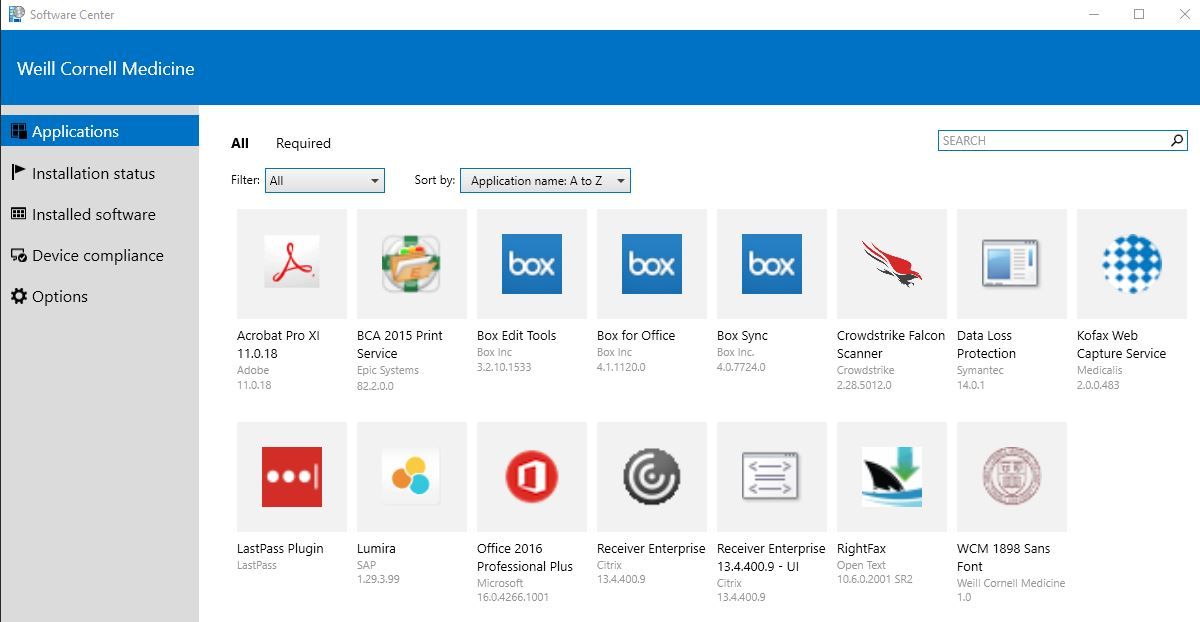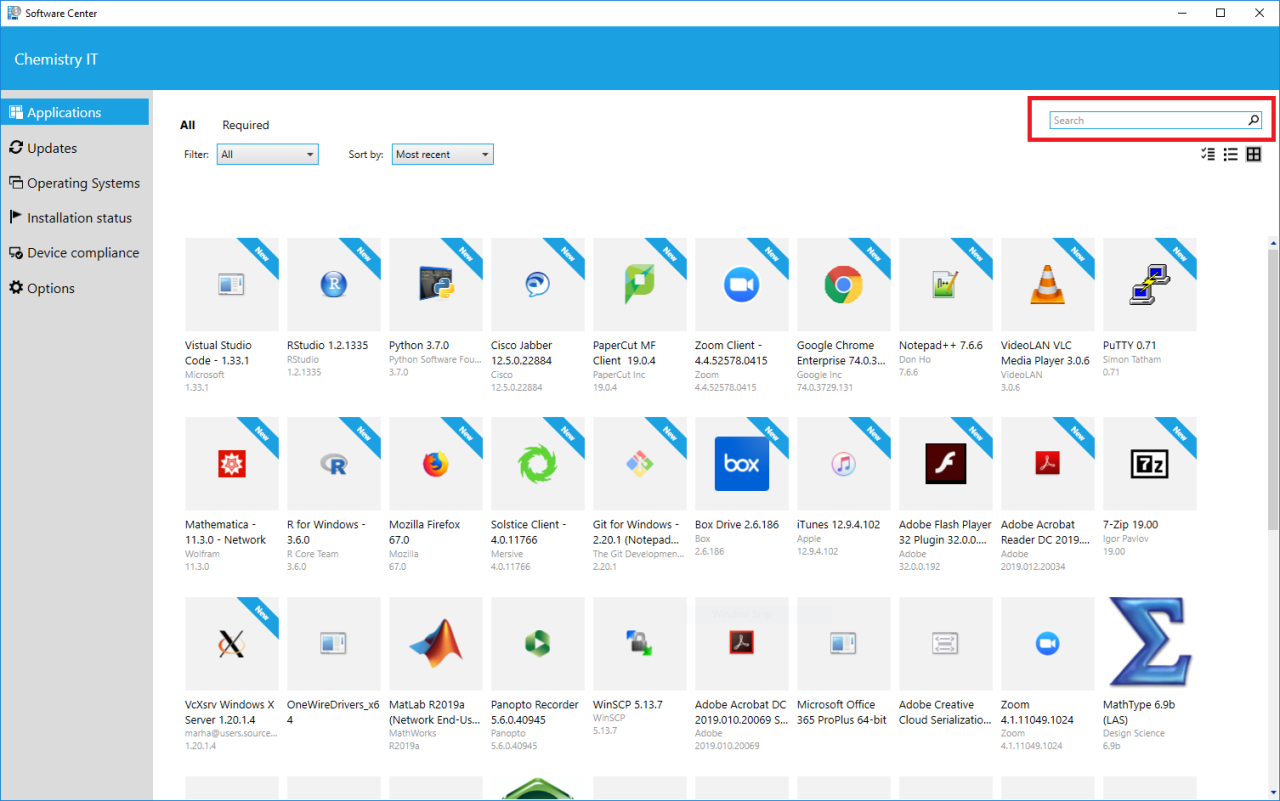Software center sets the stage for this enthralling narrative, offering readers a glimpse into a world where software management is simplified and streamlined. Imagine a central hub where you can effortlessly discover, install, update, and manage all your software applications, all in one convenient location. This is the essence of a software center, a powerful tool that has revolutionized the way we interact with technology.
Table of Contents
Software centers have become an indispensable part of the modern computing landscape, providing a user-friendly interface for accessing a vast library of software applications. Whether you’re a casual user seeking productivity tools or a seasoned developer working on complex projects, software centers offer a comprehensive solution for managing your software needs.
Software Center Benefits
Software centers offer a centralized hub for managing software applications, simplifying the process of installing, updating, and removing software on your computer. This approach provides numerous benefits, improving productivity, efficiency, and security.
Simplified Software Management
Software centers streamline the process of managing software applications, eliminating the need for manual downloads and installations. With a user-friendly interface, you can easily browse available software, read descriptions, and install applications with a few clicks. This eliminates the hassle of searching for compatible versions, downloading installers, and navigating through complex setup procedures.
Centralized Access to Applications
Software centers provide a centralized repository for all your software applications, offering a single point of access for managing your software library. This centralized approach simplifies application discovery, making it easy to locate and install the software you need. You can quickly search for applications by name, category, or s, ensuring that you have access to the software you require.
Improved Security
Software centers play a crucial role in enhancing system security by ensuring that you install applications from trusted sources. They typically offer verified software packages, reducing the risk of installing malicious or compromised software. Additionally, software centers often include features that allow you to scan applications for security vulnerabilities before installation, further enhancing system security.
Increased Productivity and Efficiency
Software centers contribute to increased productivity and efficiency by streamlining the process of installing and updating applications. Automatic updates ensure that your software is always up-to-date with the latest security patches and bug fixes, eliminating the need for manual updates and minimizing downtime. Furthermore, software centers can manage application dependencies, ensuring that all required components are installed correctly, reducing the risk of software conflicts and errors.
Reduced Software Conflicts and Compatibility Issues
Software centers help to reduce software conflicts and ensure compatibility by managing application dependencies and providing compatibility information. They ensure that all necessary components are installed correctly, minimizing the risk of software conflicts and errors. Additionally, software centers often provide information about software compatibility, allowing users to choose applications that are compatible with their operating system and other installed software.
Software Center Trends

Software centers are constantly evolving, adapting to new technologies and user needs. The way software is managed and delivered is changing, driven by trends like cloud computing and containerization. These trends are shaping the functionalities and user experience of software centers, leading to more efficient and user-friendly software management.
Cloud-Based Software Centers
Cloud-based software centers offer numerous advantages over traditional on-premises solutions. They are accessible from anywhere with an internet connection, eliminating the need for physical infrastructure. Cloud-based software centers are also scalable, allowing users to adjust resources based on demand.
- Increased Accessibility: Cloud-based software centers are accessible from any device with an internet connection, enabling users to manage software from anywhere.
- Scalability: Users can easily scale resources up or down based on their needs, eliminating the need for expensive hardware upgrades.
- Cost-Effectiveness: Cloud-based solutions often have lower upfront costs compared to on-premises software centers.
- Security: Cloud providers offer robust security measures to protect software and data.
Containerization
Containerization is a technology that packages software and its dependencies into a container, ensuring consistent execution across different environments. Containers are lightweight and portable, making them ideal for deploying and managing software in cloud-based software centers.
- Improved Portability: Containers ensure that software runs consistently across different environments, simplifying deployment and reducing compatibility issues.
- Faster Deployment: Containerization allows for rapid deployment of software, reducing time to market and increasing agility.
- Resource Efficiency: Containers use resources efficiently, allowing for better utilization of hardware and reducing costs.
Future Developments
The future of software centers is likely to be driven by artificial intelligence (AI) and machine learning (ML). AI and ML can automate tasks like software discovery, patching, and security updates, improving efficiency and reducing human error.
AI and ML will play a significant role in automating software management tasks, leading to more efficient and reliable software centers.
Software Center Security

Software centers, while offering convenience and access to a vast library of applications, also present potential security risks. Understanding these risks and implementing appropriate security measures is crucial for protecting your system and data.
Malware Threats
Malware, short for malicious software, can be distributed through software centers, posing a significant threat to users. These malicious programs can steal personal information, damage your system, or even take control of your computer.
- Trojan Horses: These programs disguise themselves as legitimate software but contain hidden malicious code that can compromise your system.
- Viruses: Viruses spread through infected files and can replicate themselves, causing damage to your system and data.
- Worms: Worms are self-replicating programs that can spread across networks, exploiting vulnerabilities to infect multiple computers.
Vulnerabilities in Software Centers
Software centers themselves can be vulnerable to attacks, allowing malicious actors to distribute malware or compromise user accounts.
- Unsecured Software: Software centers may host applications that contain security vulnerabilities, allowing attackers to exploit them to gain access to your system.
- Compromised Software Centers: Software centers can be compromised by attackers, who can then distribute malware or manipulate the available software.
- Weak Security Measures: Software centers with weak security measures, such as inadequate authentication or encryption, can be more susceptible to attacks.
Importance of Security Measures
Strong security measures are essential for protecting software centers and users from malware and vulnerabilities.
- Digital Signatures: Digital signatures verify the authenticity and integrity of software, ensuring that it has not been tampered with or altered.
- Sandboxing: Sandboxing isolates applications from the rest of your system, limiting the potential damage they can cause if they contain malware.
- Regular Security Updates: Regular security updates patch vulnerabilities in software centers and applications, making them less susceptible to attacks.
Recommendations for Users
Users can take several steps to ensure the security of their software centers.
- Use Reputable Software Centers: Stick to reputable software centers with a proven track record of security and reliability.
- Verify Software Authenticity: Always verify the authenticity of software before downloading and installing it. Look for digital signatures and read reviews from other users.
- Keep Software Updated: Regularly update your software center and applications to ensure you have the latest security patches.
- Use Antivirus Software: Install and maintain a reliable antivirus program on your computer to detect and remove malware.
- Be Cautious of Downloads: Avoid downloading software from unknown or untrusted sources.
Software Center Integration

Software centers are not isolated entities; they thrive in a connected ecosystem. Integration with other software tools and platforms is crucial for streamlining software development workflows and enhancing overall software management. This integration enables a seamless flow of information and processes, leading to improved efficiency and productivity.
Integration with Version Control Systems
Version control systems are essential for managing code changes and collaborating on software projects. Integrating software centers with version control systems allows for the tracking of software packages and their dependencies, ensuring consistency and preventing conflicts during development.
- Automated Package Updates: Software centers can automatically update packages based on changes in the version control system, eliminating manual updates and reducing the risk of outdated software.
- Dependency Management: Integration enables software centers to manage dependencies between packages, ensuring that all required components are installed and compatible.
- Rollback Capabilities: In case of errors or conflicts, integration allows for easy rollbacks to previous package versions, minimizing downtime and disruption.
Integration with Build Automation Tools
Build automation tools streamline the process of building and deploying software applications. Integrating software centers with these tools automates the process of installing and configuring software packages during the build process.
- Consistent Environments: Integration ensures that all build environments have the same software packages and configurations, minimizing discrepancies and ensuring consistent results.
- Automated Testing: Software centers can be integrated with automated testing frameworks, enabling the automatic testing of software packages during the build process.
- Deployment Automation: Integration with deployment tools allows for the automated deployment of software packages to different environments, such as development, testing, and production.
Integration with Cloud Services, Software center
Cloud services are becoming increasingly popular for software development and deployment. Integrating software centers with cloud platforms provides access to a wide range of services, including storage, compute, and networking resources.
- Cloud-Native Package Management: Software centers can be used to manage cloud-native packages, such as containers and serverless functions, simplifying the deployment and management of cloud applications.
- Scalability and Flexibility: Integration with cloud services allows for the scaling of software deployments based on demand, providing flexibility and cost-effectiveness.
- Disaster Recovery: Cloud integration enables the creation of disaster recovery plans, ensuring that software applications can be restored quickly in case of outages.
Software Center Future
Software centers are poised for a significant transformation, driven by the rapid evolution of software development and the increasing complexity of software management. The future holds exciting possibilities for software centers, promising to revolutionize how organizations manage and deploy software.
Artificial Intelligence and Machine Learning
Artificial intelligence (AI) and machine learning (ML) are expected to play a pivotal role in enhancing software center functionalities. AI-powered algorithms can analyze vast amounts of data related to software usage, performance, and security, providing valuable insights for optimizing software deployments and reducing operational costs.
- AI-driven automation can streamline repetitive tasks, such as software updates and patching, freeing up IT staff to focus on more strategic initiatives.
- Machine learning algorithms can predict software vulnerabilities and proactively address them before they become critical security threats.
- AI can personalize software recommendations based on individual user needs and preferences, improving user experience and productivity.
Emerging Technologies and Trends
Software centers will need to adapt to emerging technologies and trends in the software industry, such as cloud computing, containerization, and serverless computing.
- Cloud-based software centers offer scalability, flexibility, and cost-effectiveness, enabling organizations to manage software deployments across multiple platforms and locations.
- Containerization technologies, such as Docker and Kubernetes, simplify software packaging and deployment, allowing organizations to deploy and manage software applications in a consistent and portable manner.
- Serverless computing platforms, such as AWS Lambda and Azure Functions, enable organizations to run code without managing servers, further simplifying software deployment and reducing operational overhead.
Concluding Remarks
In conclusion, software centers have emerged as a cornerstone of modern software management, offering a centralized platform for discovering, installing, and maintaining software applications. From personal computing to enterprise deployments, software centers empower users with the tools they need to navigate the ever-evolving world of software. As technology continues to advance, software centers will undoubtedly play an even more critical role in shaping the future of software management.
Software centers are hubs for a wide range of applications, offering tools for various needs. For those involved in video production and editing, a key software within these centers is adobe media encoder , a powerful tool for converting and optimizing media files for different platforms.
This software, along with others, enhances the functionality of software centers, making them essential resources for professionals and enthusiasts alike.
